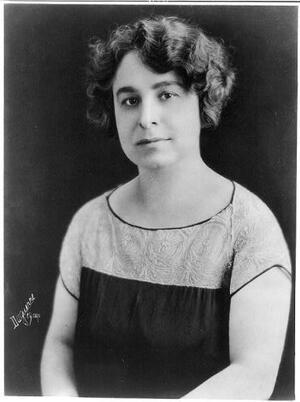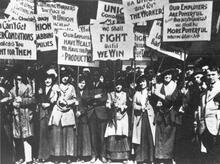Lillian Herstein
Lillian Herstein came to labor activism by an unusual route for a woman of her time, through her career as a teacher. In 1912 she began teaching in a Chicago high school and joined the Federation of Women High School Teachers, representing that union (which became the Chicago Teachers Union in 1937) on the Chicago Federation of Labor and serving as the only woman on its executive board for twenty-five years. She worked on joint education projects between CFL and the Women’s Trade Union League, organizing workers, teaching classes at the Chicago Labor College, and advocating for worker education. After her retirement from teaching in 1952, she worked with the Jewish Labor Committee on race relations, helping integrate labor unions.
The history of Jewish women in the American labor movement tends to focus on those whose careers unfolded in the needle trades. Such was not the case with Lillian Herstein, who was a teacher and a nationally known labor leader.
Early Life and Teaching
Ethel Lillian Herstein, the youngest of six children, was born on April 12, 1886, in Chicago. Her parents, Wolf and Cipe Belle, emigrated from Vilkovishk, Lithuania, shortly after the U.S. Civil War, not only for economic reasons but because of Wolf’s admiration for Abraham Lincoln and his ideals.
Wolf Herstein worked as the sexton of a synagogue, while his wife operated the C. B. Herstein Hebrew Book Store. When Wolf died, Cipe struggled to keep the store open, sending the older children out to work. Only twelve-year-old Lillian remained in school. With family help and a job, she went on to graduate from Northwestern University in 1907.
Convinced that teaching was “the most wonderful thing in the world,” Lillian found positions in small rural schools. In 1912, she became a Chicago high school teacher and joined a union, the Federation of Women High School Teachers. Within a short time, she became the federation’s delegate to the Chicago Federation of Labor (CFL). When the various teachers’ organizations consolidated into the Chicago Teachers Union in 1937, Herstein represented the union in the CFL, serving as the only woman on its executive board for twenty-five years. She used her position to gain the CFL’s support for school issues, often expressing her views on radio.
Herstein’s career as a union organizer was launched when she was asked by Agnes Nestor of the Women’s Trade Union League (WTUL) to speak to the CFL about the league’s educational program for workers. Impressed with her speaking skills, the CFL asked her to go on its speakers’ circuit. Herstein went on to organize couture seamstresses, steel workers, packing house workers, newspaper reporters, coal miners, and sleeping-car porters.
Advocacy and Politics
Through her work with the WTUL, Herstein became an advocate of workers’ education. She taught classes in English and public speaking at the Chicago Labor College, a project of the WTUL and CFL. As the workers’ education movement spread in the 1920s and 1930s, she taught summer courses at Bryn Mawr College and the University of Wisconsin. During the 1920s, Herstein also taught at Chicago’s Crane Junior College. One of her pupils, Supreme Court Justice Arthur Goldberg, credited her with inspiring him to become a labor lawyer. An advocate of free junior colleges, Herstein successfully fought to keep them open during the Depression years.
Between 1922 and 1932, Herstein entered politics, running unsuccessfully for state and federal offices. In 1937, she was asked to become the adviser on child labor legislation at a meeting of the International Labor Organization in Geneva.
Returning to this country, she became involved in a fight between the American Federation of Labor and its Committee on Industrial Organization (CIO). Convinced that industrial organization was the only way for unskilled minorities to come into the labor movement, she feared the feuding that might arise from the CIO forming its own national organization. A passionate believer in arbitration, she tried unsuccessfully to heal the breach.
During World War II, Herstein was sent by the War Production Board to the West Coast, where she plunged into the tasks of providing housing, decent working conditions, and day care centers for defense workers.
Legacy
Herstein retired from the city college system in 1952. During her retirement years, she worked with the Jewish Labor Committee to improve race relations, receiving an award from the Chicago Commission on Human Relations in 1953 for her work in integrating building trades. Herstein was an active member of Hadassah, Histradrut, the National Council of Jewish Women, and the American Civil Liberties Union.
She died on August 9, 1983, at age ninety-seven.
Born into an Eastern European intellectual family, Herstein grew to adulthood with a passion for social justice and an enduring belief in the value of education. She came to maturity in fin-de-siècle Chicago, when its intellectual atmosphere was enhanced by such great social reformers as Jane Addams, John Dewey, and Thorstein Veblen. Educated young people could not help but be influenced by these thinkers. Thus Herstein’s life represents a blending of the particular and the universal, a paradigm of the American Jewish experience.
Engelbrecht, Lester E. "Lillian Herstein: Teacher and Activist." Labor's Heritage vol. 1, no. 2 (April 1989).
Ginger, Ray. Altgeld’s America (1986).
Herstein, Lillian. Interviews by Elizabeth Balanoff (1970–1971), Oral History Project in Labor History, Roosevelt University Archives, Chicago, and Papers. Chicago Historical Society, and Chicago Jewish Archives, Spertus Institute of Jewish Studies, Chicago.
Kornbluh, Joyce L. A New Deal for Workers’ Education (1987).
Payne, Elizabeth Ann. Reform, Labor, and Feminism (1988).
Reid, Robert L., ed. Battleground: The Autobiography of Margaret A. Haley (1982).
Wrigley, Julia. Class Politics and Public Schools: Chicago, 1900–1950 (1982).
Zieger, Robert H. American Workers, American Unions, 1920–1985 (1986).




